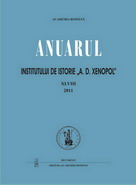Constituirea Grupului Etnic German din România şi relaţiile cu Biserica Evanghelică din Transilvania în primii ani ai "erei" Andreas Schmidt. 1940
THE FORMATION OF THE GERMAN ETHNIC GROUP FROM ROMANIA AND ITS RELATIONS WITH THE LUTHERAN CHURCH
Author(s): Ottmar TraşcăSubject(s): History
Published by: Editura Academiei Române
Keywords: German Ethnic Group; Andreas Schimdt; radical Nazi current; Lutheran Church
Summary/Abstract: Andreas Schimdt’s appointment at the head of the German Ethnic Group caused consternation among the German ethnic citizens of Romania and was received with undissimulated reserve by major personalities, mainly former political, economical and cultural leaders of the German minority. Following the dispositions received from Berlin via the Volksdeutsche Mittelstelle, Schimdt rapidly began to reorganize the executive structures of the minority, officially marking the alignment (Gleichschaltung) of the Ethnic Group (i.e. the loyal adoption and application of the political, cultural and economical model in place in Germany). The evolutions naturally triggered adverse reactions from various institutions and personalities of the German minority, chiefly from the Lutheran and Catholic Churches. The deposition of bishop Viktor Glondys and his replacement with Wilhelm Staedel marked undoubtedly an unquestionable victory of the radical Nazi current and a decisive step towards the subordination of the Lutheran Church, stripped off its main attributions by the leaders of the German Ethnic Group. The campaign initiated by these leaders in the aim of aligning the Lutheran Church was accompanied by a strong anti-Christian styled propaganda among the youth, causing great concern in Bucharest.
Journal: Anuarul Institutului de Istorie »A.D. Xenopol« - Iaşi
- Issue Year: XLVIII/2011
- Issue No: 48
- Page Range: 315-327
- Page Count: 13
- Language: Romanian

